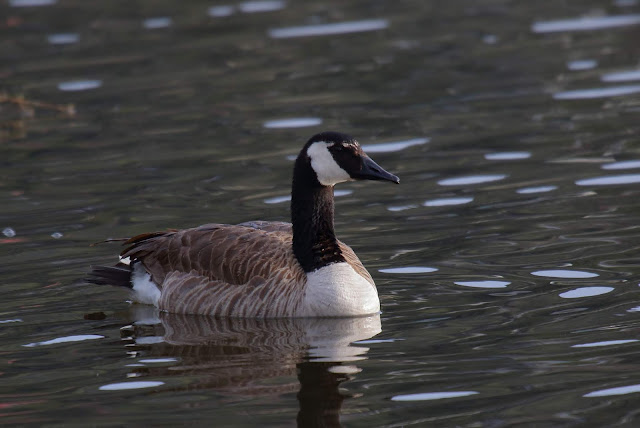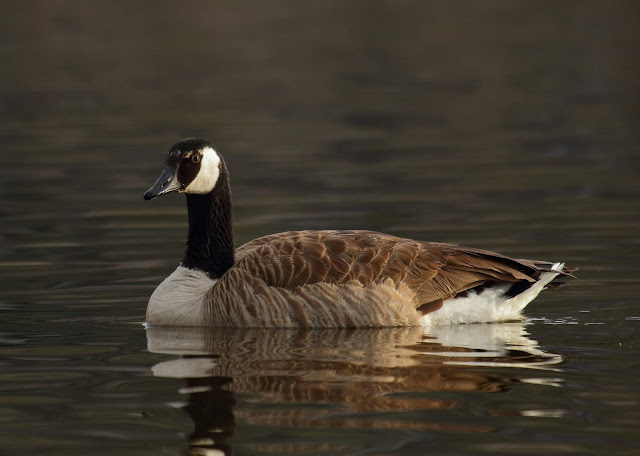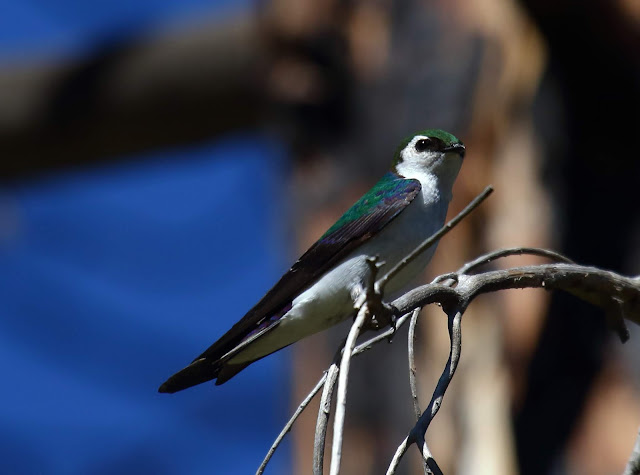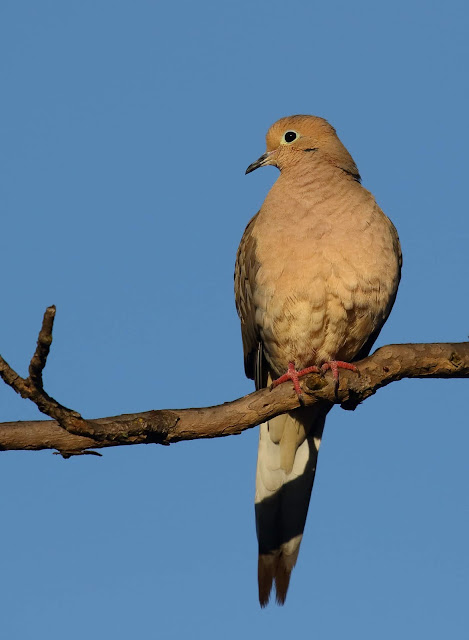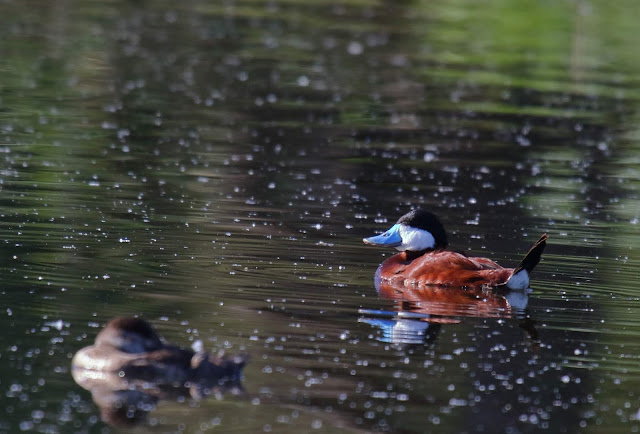 |
| Ruddy Duck. April 19, 2019. Escondido, California. |
Tuesday, April 30, 2019
Laughing Duck at Kit Carson Park
Ruddy Ducks breed in California. Their numbers are supplemented in the winter by birds migrating out of the northern parts of this bird's range. Those winter birds are fairly drab, males and females somewhat similar brown with a patch of paleness on the cheeks. In the spring, though, the male sports that deep ruddy color for which it is named. Below is a photo of this happy duck. Okay, maybe I'm anthropomorphizing slightly. Or maybe not. Can you prove this duck isn't merrily laughing?
Monday, April 29, 2019
Canada Goose at Lake Cuyamaca
Sunday, April 28, 2019
Brewer's Blackbird at Lake Cuyamaca
Brewer's Blackbirds are Lake Cuyamaca's "pest" birds. They are a common parking lot birds, leaving white spots on your windshield. I photographed these along the lakeshore where they are less of a problem. But they make eating on the outdoor patio of the lakeside restaurant a bit unsanitary if you don't keep your food covered!
 |
| Brewer's Blackbird. April 7, 2019. Lake Cuyamaca, California. |
Saturday, April 27, 2019
European Starling at Stonewall Mine
European Starlings have been part of the North American bird fauna for over 70 years. Yes, they severely misplaced native secondary cavity nesting birds (especially bluebirds) in many areas as they spread rapidly in sky-covering flocks. In most areas starlings have now reached equilibrium with the native birds. After 70 generations, perhaps it's time to consider that starlings are now "native"?
European Starlings don't seem to me to be nearly as abundant in San Diego as they are in more northerly cities, such as Portland, Oregon. There evening fall flocks of roosting starlings number into the multiple 10's of thousands. Why, I didn't even include this species in the 30 most common backyard birds of San Diego!
Even if we have some animosity at what they did to native bird populations (through no fault of their own--it was people who encouraged and released them), can we at least take a moment to consider that at times, if we look without bias, starlings can be quite beautiful?
European Starlings don't seem to me to be nearly as abundant in San Diego as they are in more northerly cities, such as Portland, Oregon. There evening fall flocks of roosting starlings number into the multiple 10's of thousands. Why, I didn't even include this species in the 30 most common backyard birds of San Diego!
Even if we have some animosity at what they did to native bird populations (through no fault of their own--it was people who encouraged and released them), can we at least take a moment to consider that at times, if we look without bias, starlings can be quite beautiful?
 |
| European Starling. April 7, 2019. Stonewall Mine, California. |
Friday, April 26, 2019
Hairy Woodpecker at Stonewall Mine
Thursday, April 25, 2019
Cassin's Vireo at Stonewall Mine
Wednesday, April 24, 2019
Violet-green Swallow at Stonewall Mine
Tuesday, April 23, 2019
Rare bird: Neotropic Cormorant at Lake Cuyamaca
First found on April 4th, 2019 by Jim Pawlicki, two Neotropic Cormorants were at Lake Cuyamaca for several days. I was able to visit on April 7th and get the photos presented here.
I'm not sure I would have identified these birds if I didn't know they were there. Oh, I would have had I really looked at them. But I don't think I would have bothered looking closely at cormorants in the mountains! I would have counted the lumps as Double-crested, added them to eBird, and moved on. It's all about expectation. There are a couple of photos here of birds isolated that certainly would have broken through my expectation bias had I seen them--a bird only 2/3 the size, but perhaps only 1/4 the bulk of the Double-crested Cormorants.
Here are San Diego records of Neotropic Cormorant (from eBird photos):
1) October 12 to December 6, 2014 Lake O'Neill, Camp Pendleton.
2) October 3 to November 26, 2015 Lake O'Neill, Camp Pendleton (presumed same individual as above).
3) October 16 to November 2, 2016 Lake O'Neill, Camp Pendleton (presumed same individual as above).
4) March 6, 2017 Lower Otay Reservoir.
5) April 4, 2019 to April 9, 2019 Lake Cuyamaca.
So this is apparently the 5th record, but only the 3rd and 4th different individuals. October to April, with Double-crested Cormorants, anywhere on fresh water. You can bet I'll be more aware going forward. I suspect I'm not the only one.
This bird was quite distant and the low light made photography difficult. I ended up taking about 500 frames of the birds, changing settings constantly, in order to get these pics. You can click on any of the photos to bring up a larger size.
Interestingly, there were two Neotropic Cormorants together, an adult and apparent immature. The immature bird presented some problem as it appeared much more pale and faded than typical. There was some hesitancy about this pale second bird. Eventually, though, the "hybrid hypothesis" for this second bird was dismissed. Apparently, rarely, immature Neotropic Cormorants can be this pale.
Below are photos specifically of this pale bird. The size and throat pouch shape match those of the adult bird. Again, you can click on the photos to bring up a larger view.
 |
From left to right: Double-crested Cormorant, immature Neotropic Cormorant, 2 more Double-crested Cormorants,
and adult Neotropic Cormorant. April 7, 2019. Lake Cuyamaca, California.
|
Here are San Diego records of Neotropic Cormorant (from eBird photos):
1) October 12 to December 6, 2014 Lake O'Neill, Camp Pendleton.
2) October 3 to November 26, 2015 Lake O'Neill, Camp Pendleton (presumed same individual as above).
3) October 16 to November 2, 2016 Lake O'Neill, Camp Pendleton (presumed same individual as above).
4) March 6, 2017 Lower Otay Reservoir.
5) April 4, 2019 to April 9, 2019 Lake Cuyamaca.
So this is apparently the 5th record, but only the 3rd and 4th different individuals. October to April, with Double-crested Cormorants, anywhere on fresh water. You can bet I'll be more aware going forward. I suspect I'm not the only one.
This bird was quite distant and the low light made photography difficult. I ended up taking about 500 frames of the birds, changing settings constantly, in order to get these pics. You can click on any of the photos to bring up a larger size.
 |
The adult Neotropic Cormorant on the right with wings open shows the characteristic small orange throat pouch
shaped as a sharp point outlined with white feathers (especially on the bottom).
|
 |
| An adult Double-crested Cormorant (right, wings open) dwarfs the adult Neotropic Cormorant (left). |
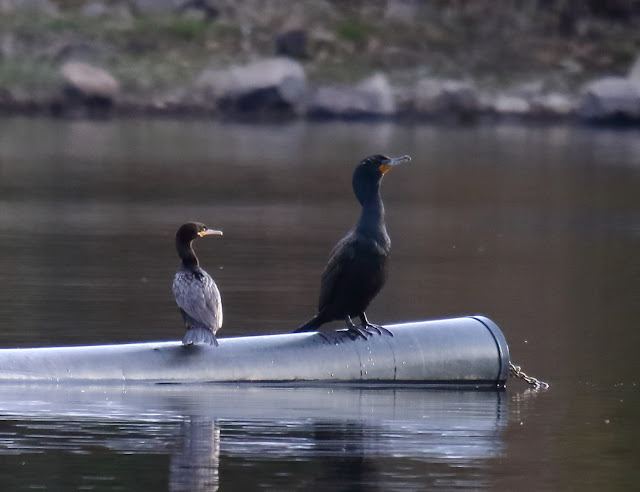 |
The size difference is obvious, but the shape of the throat pouch is easily seen and compared
(pointed on Neotropic, left; rounded or squared on Double-crested Cormorant, right).
|
Below are photos specifically of this pale bird. The size and throat pouch shape match those of the adult bird. Again, you can click on the photos to bring up a larger view.
Monday, April 22, 2019
Turtles at Kit Carson Park
I don't know that much about turtles (except for an Ogden Nash limerick).
Here is a great website on California herps. From this website I found out what I suspected. These turtles are all non-native escaped pets--or at least, their recent ancestors were. The big turtle showing some red stripes on the underside ("plastron"--new vocabulary word!) is the Western Painted Turtle (Chrysemys picta bellii). Most of the others here have yellow stripes on the plastron and a red mark behind the eye--the Red-eared Slider (Trachemys scripta elgans).
Here is a great website on California herps. From this website I found out what I suspected. These turtles are all non-native escaped pets--or at least, their recent ancestors were. The big turtle showing some red stripes on the underside ("plastron"--new vocabulary word!) is the Western Painted Turtle (Chrysemys picta bellii). Most of the others here have yellow stripes on the plastron and a red mark behind the eye--the Red-eared Slider (Trachemys scripta elgans).
 |
| Sunning turtles. March 29, 2019. Escondido, California. |
Sunday, April 21, 2019
Mourning Dove at Kit Carson Park
Saturday, April 20, 2019
Ring-necked Duck at Kit Carson Park
Friday, April 19, 2019
American Coot at Kit Carson Park
An example of a more interesting pose, followed by the boring standard "field guide pose." Remember, I challenged you to find more interesting poses in this past post on coots.
 |
| American Coot. March 29, 2019. Escondido, California. |
Thursday, April 18, 2019
Another 10 common backyard birds of San Diego
This post adds 10 more backyard birds to the initial list of 10 I felt were most common.
Now, as Tito mentioned in his comments to the last post, every backyard is a bit different. He thought Song Sparrow should definitely be one of the 10 most common. He lives near the beach, so that's to be expected. I don't have that species in my dry inland backyard, and only hear them about 3 times a year in my neighborhood. But Tito's yard is evidently different. Not to worry, though! Song Sparrow is definitely in the top 30. Today, though, I list the species I deem #11-20 most common backyard birds in the San Diego area. The final 10 (yes, including Song Sparrow) is coming in a future post.
If you found the first ten species in your yard, can you now find the next ten? The first 10 tended to be ones that were easily attracted with food or water. This next set of 10 is attracted primarily by habitat--they are attracted to our landscaping, or they are birds of native chaparral that brushes up against the edges of towns, if you happen to live on the edge of more rural, open areas.
11) Red-shouldered Hawk
Red-shouldered Hawks prefer woods and riparian edges more so than Red-tailed Hawks. Thus, town edges, pastures, creek sides, oaks, sycamores, and eucalyptus groves all support Red-shouldered Hawks and their loud, repeated "keer" calls. Even if none visit your yard, you'll likely see them soaring overhead--perhaps chased by noisy crows!
12) Nuttall's Woodpecker
If your backyard has any oaks or sycamore trees, you'll likely have a pair of Nuttall's Woodpeckers that frequents it with their rattling calls.
13) Hooded Oriole
Do you have a tall palm tree in your yard? Then you have Hooded Orioles that visit for the summer, late March into September. Listen for their chatters and chirps and flute-like whistled notes. There is a feeder for orioles--similar to a hummingbird feeder but with orange slices and jelly--for closer views. They will also be attracted to water features--bird baths or fountains.
14) Yellow-rumped Warbler
This abundant warbler may breed in small numbers in San Diego's highest forested mountains, and from here northward to Alaska. In winter it is found in lowlands from the Pacific Northwest into Mexico. Unlike most warblers, this species can switch from insects in summer to fruits in winter. Thus, it can remain farther north in winter than other warbler species. You may find it in most deciduous backyard trees in "winter" (October to April).
15) House Sparrow
House Sparrows are urban dwellers--except when they are farm dwellers. They are less common in suburban residential. Because they are often messy and noisy, most people don't actively try to attract this species to their backyards. They will take over bluebird nest boxes, but have weaker feet. Thus, other cavity nesting birds (bluebirds, swallows, wrens, nuthatches, titmouses) will have a chance against them if there is no perch on the nest box. Likewise, these birds eat millet, the "filler" seed in bags of generic "mixed seeds" that many native birds don't like. So, if you feed black oil sunflowers, rather than "mixed seeds," you may have less problem with these birds taking over.
16) Say's Phoebe
The Say's Phoebe prefers dry pastures and chaparral. In winter you may find them in open lawn spaces and parks around your neighborhood. There they chase flying insects low along the ground. If you live in a more rural area, they may nest in an open corner of an outbuilding, or perhaps on top of a light fixture on your porch.
17) Eurasian Collared-Dove
Perhaps the fastest colonizing bird in the world. After taking over Europe in the last century they repeated their conquest in the New World. Escaped cage birds apparently flew from the Bahamas to Florida in the 1980's. Their method of colonizing is to breed for a couple of years in one area and build up large numbers, then many of the colony disperse, flying 500 miles or more and do it again. They tend to spread in a northwesterly direction first, then back fill. Their breeding sites also tend to change over the years. You'll find these loud pigeons around human habitation, residential areas and farms, similar to where Mourning Doves are found, but not so much in the open country.
18) Cassin's Kingbird
The Cassin's Kingbird is a year-round resident in southern California. It prefers the lowlands, pastures, and lone tall trees over large expanses of lawn. They flycatch at tree-top level.
19) Bushtit
"What are those tiny gray mouse-like birds crawling around my shrubs under the window?" Those are Bushtits. They are likely searching for spiders to eat. It's the eyes! Females have pale eyes, males are dark. Otherwise they appear the same. A pair builds a gray sock-like nest of lichens and spider webs that hangs down under a branch about 6 feet off the ground. For the rest of the year, though, they are found in flocks of 20-50 birds.
20) House Wren
This is a common bird of chaparral and residential bushes and brush piles. Resident birds are supplemented by winter visitors from the north. They eat insects and grubs. The more overgrown your yard with mature shrubs, the more likely your yard will host House Wrens in winter. If your yard is brushy enough, a pair may stay throughout the year and nest in a nest box or other cavity.
Want more? The final 10 common backyard birds of San Diego is here!
Now, as Tito mentioned in his comments to the last post, every backyard is a bit different. He thought Song Sparrow should definitely be one of the 10 most common. He lives near the beach, so that's to be expected. I don't have that species in my dry inland backyard, and only hear them about 3 times a year in my neighborhood. But Tito's yard is evidently different. Not to worry, though! Song Sparrow is definitely in the top 30. Today, though, I list the species I deem #11-20 most common backyard birds in the San Diego area. The final 10 (yes, including Song Sparrow) is coming in a future post.
If you found the first ten species in your yard, can you now find the next ten? The first 10 tended to be ones that were easily attracted with food or water. This next set of 10 is attracted primarily by habitat--they are attracted to our landscaping, or they are birds of native chaparral that brushes up against the edges of towns, if you happen to live on the edge of more rural, open areas.
11) Red-shouldered Hawk
 |
| Adult Red-shouldered Hawk. December 25, 2014. Ramona, California. |
 |
| Immature Red-shouldered Hawk. October 7, 2018. Mt Laguna, California. |
12) Nuttall's Woodpecker
 |
| Male Nuttall's Woodpecker. February 2, 2014. Lake Hodges, California. |
 |
| Female Nuttall's Woodpecker. February 8, 2017. Escondido, California. |
13) Hooded Oriole
 |
| Male Hooded Oriole. April 6, 2014. Escondido, California. |
 |
| Female Hooded Oriole. April 16, 2017. Vallecito County Park, California. |
14) Yellow-rumped Warbler
 |
| Breeding Yellow-rumped Warbler (Audubon's form). April 29, 2010. Forest Grove, Oregon. |
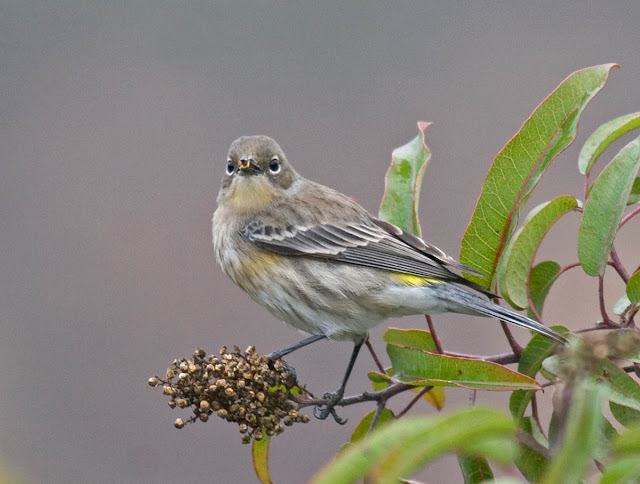 |
| Non-breeding Yellow-rumped Warbler (Audubon's form). November 17, 2017. Escondido, California. |
15) House Sparrow
 |
| Male House Sparrow carrying nesting material. March 18, 2019. Borrego Springs, California. |
 |
| Female House Sparrow. February 16, 2011. Beaverton, Oregon. |
16) Say's Phoebe
 |
| Say's Phoebe. December 22, 2013. Mission Bay, California. |
17) Eurasian Collared-Dove
 |
| Eurasian Collared-Dove. March 12, 2017. Borrego Springs, California. |
18) Cassin's Kingbird
 |
| Cassin's Kingbird. November 3, 2018. Ramona, California. |
19) Bushtit
 |
| Male Bushtit. October 4, 2015. San Elijo Lagoon, California. |
 |
| Female Bushtit. October 9, 2009. Forest Grove, Oregon. |
20) House Wren
 |
| House Wren. July 4, 2018. Lake Hodges, California. |
Want more? The final 10 common backyard birds of San Diego is here!
Subscribe to:
Posts (Atom)


